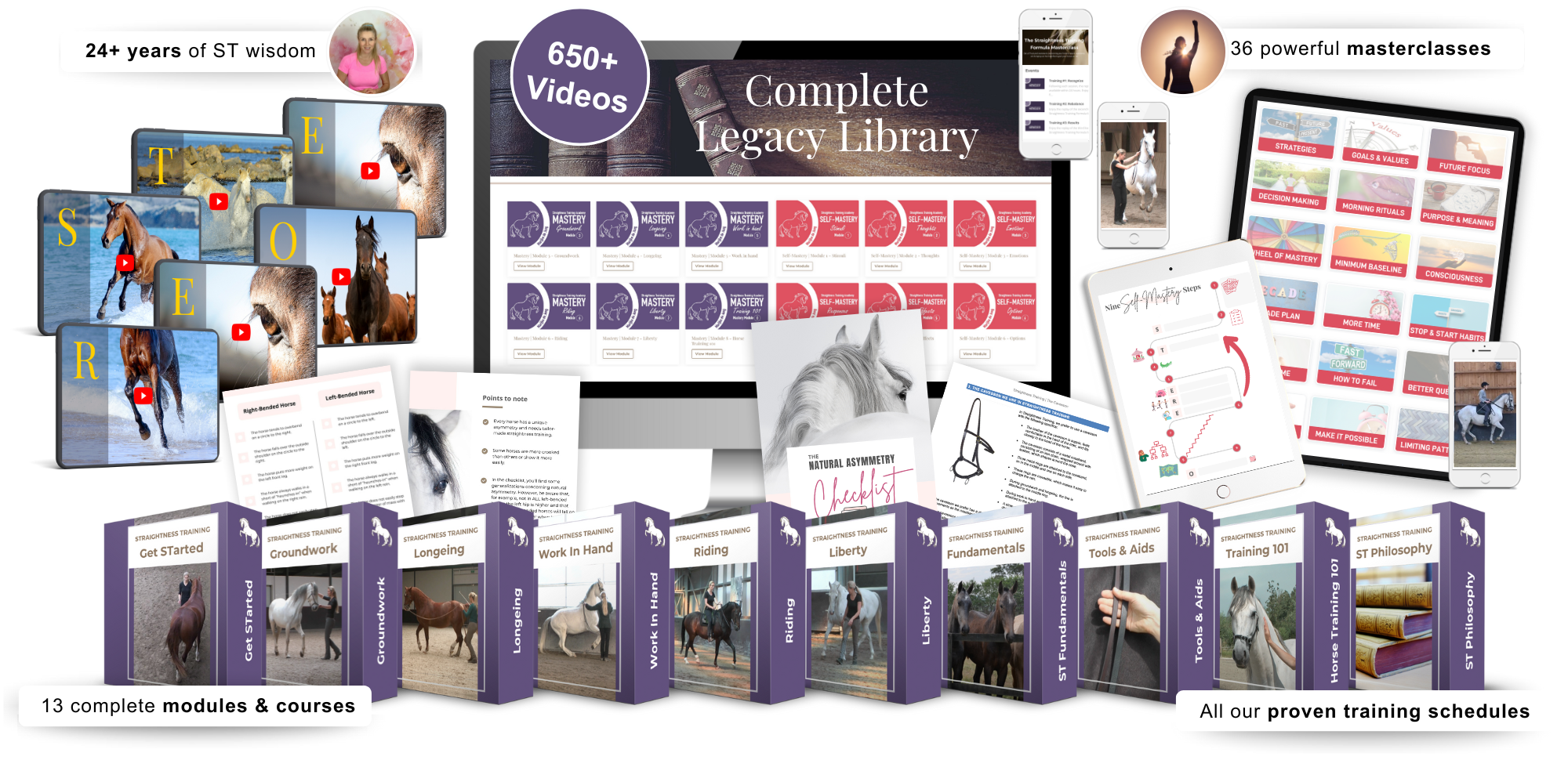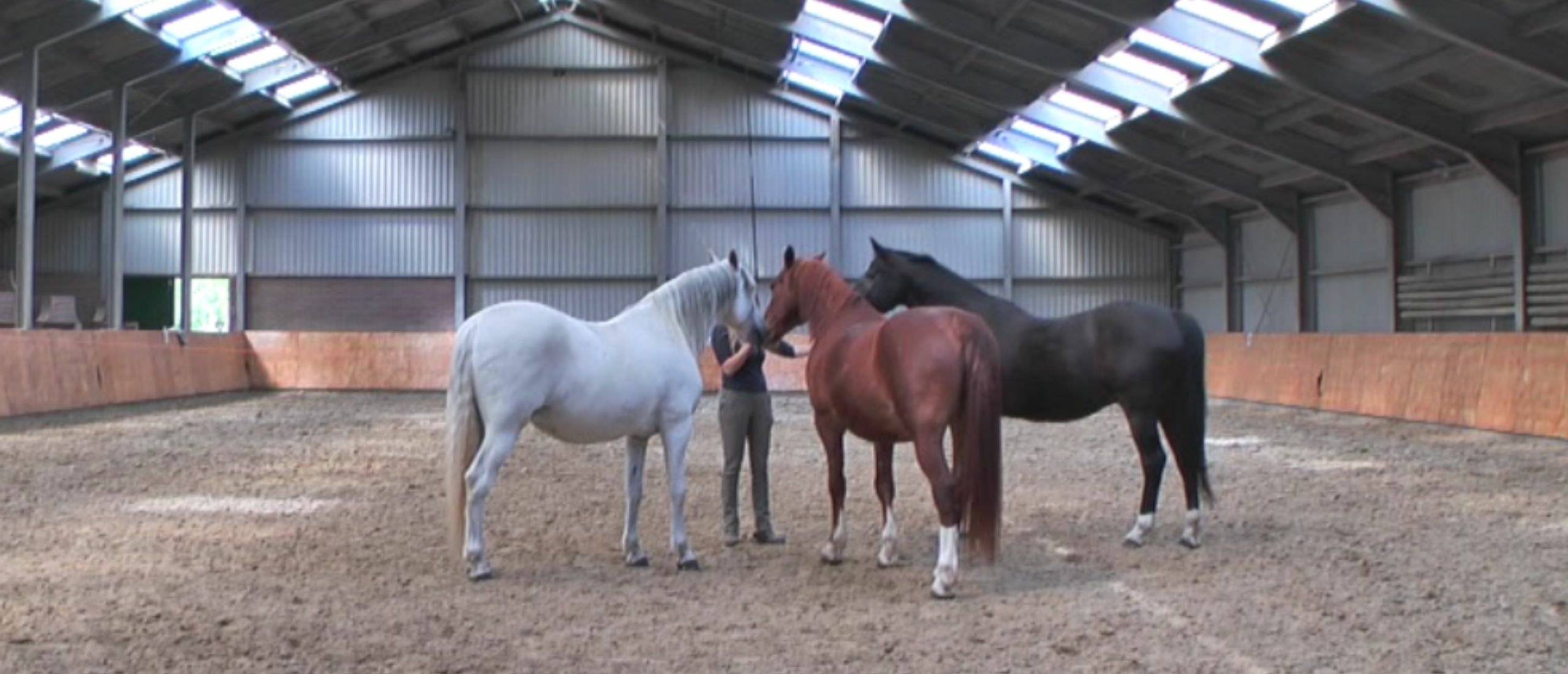
3 Leadership styles

If you have a vision for yourself and your horse and you want to have a good relationship, achieve something or reach some level in your chosen discipline, then you have to be a good leader to your horse.
Now if you feel uncomfortable with the use of the words ‘leader’ and ‘leadership’ feel free to replace the word ‘leadership’ for ‘guidance’, or ‘respectful partnership’ and the word ‘leader’ for ‘teacher’ or ‘guide’ or ‘partner’. It doesn’t matter. Words are only symbols to define something, they form a linguistic representation of the world. Remember: The map isn’t the territory anyway
True leaders/guides/teachers have the ability to care, to give their horse what he needs and to connect with their horse so they can teach him the things he needs to know.
In my opinion, leadership is mostly about growth and progress:
- It’s the capacity to create a safe and comfortable environment where your horse is able to learn new things.
- It’s the ability to influence your horse’s behavior and action in a positive way.
- It’s the quality to be able to motivate you horse to do things.
- It’s the ability to improve his skills and to develop his talents in your chosen discipline.
In my experience, there are three basic leadership styles.
Styles of leadership
A leadership style is a manner and approach of providing purpose and direction in the training with your horse.
I define the three major leadership styles as:
1. Telling
2. Coaching
3. Hand over
It has been my observation that good horse trainers use all three styles, and less successful leaders tend to stick with one style.
1. Telling style
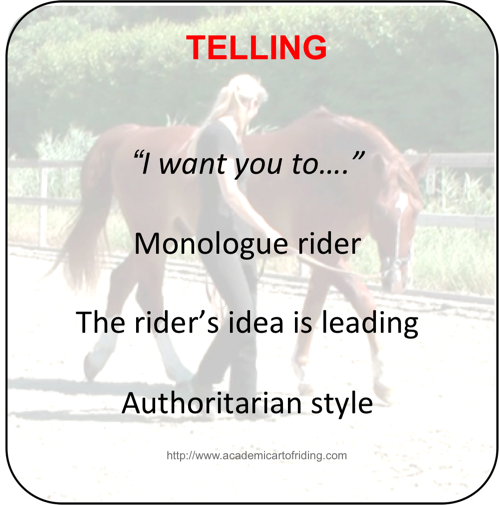
This style is used when you tell your horse what you want him to do and how you want it accomplished.
Your idea is leading, you define purpose and direction and provide the what, how, why, when and where the horse has to do the task or exercise.
The ‘telling’ style is more like a monologue with only you expressing your thoughts and wants.
The ‘telling’ style should be used on certain occasions and some of the appropriate conditions to use it are:
- When you establish the boundaries and limitations between you and the horse in a positive manner. A horse needs to know that you are clearly setting the rules for your life together, so that you are safe and the horse feels safe and comfortable too.
- When the horse is learning a new thing, exercise or aid. It’s important that the leader is competent and a good teacher and that the horse is motivated to learn a new skill.
- When you have to protect your ‘herd of two’, in case of a dangerous situation or an emergency.
Points to note
This style is also called the ‘authoritarian’ style, but it has nothing to do with being a dictator:
- ‘Telling’ leaders with a negative attitude often act domineering and superior with horses. Some of them tend to think of this style as a vehicle for ‘yelling’ instead of ‘telling’. They force a horse to do something and lead by threats and abusing their power. This is not the ‘telling’ style, rather it is an abusive, unprofessional style and it has no place in a leader’s repertoire. Leaders who continuously work out of the negative are ‘bosses’ to their horse, while those who primarily work out of the positive are considered ‘real leaders’.
- Positive leaders appreciate the efforts of the horse, use rewards to motivate the horse and to reinforce behavior, neglect the things they don’t like and try to avoid force and penalties. They know penalties have a place in a leader’s repertoire of tools, but must be avoid as much as possible or used very carefully due to its high cost on the horse’s spirit.
- “Telling’ leaders are sometimes more task-oriented and less horse-oriented. They are very structured and result-driven. Sometimes they believe they get results by consistently giving horses ‘orders’ and urging them to deliver results. But there is more to influencing than simply passing along orders.
If you want your horse to be obedient, but you don’t want your well-trained horse to be a robot and if you want to gain more commitment and motivation from your horse, then you should also use the ‘coaching’ style.
2. Coaching style
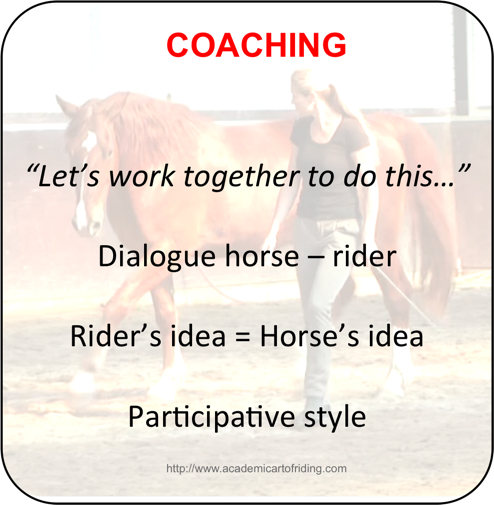
In this style, you set the goals, however you encourage a healthy dialog to facilitate exchange of ideas.
A prerequisite for this kind of leadership is the mutual respect between horse and rider. The coaching style is a more participative style, however, you as the leader maintain the final authority.
This is a useful style when your horse is skillful, capable, calm, confident and when he knows his job.
A good coach develops the competence and commitment of the horse so the horse is self-motivated rather than dependent on the leader (and his tools and aids) for direction and guidance.
For example:
- You might be able to do a wonderful piaffe with your horse with a bridle. Using the coaching style you can check if your horse wants to do the piaffe together with you without tools, rather then to be made to perform this exercise.
- You can check if your horse wants to curve his body to the inside, or still have to make him bend with a rein or longe line all the time.
What we strive for is the horse’s ‘willingness’ instead of ‘obedience’, so that he will want to do what we want, rather then be made to behave.
You can check very well if your idea is adopted by your horse when you are working with your horse at liberty.
The coaching style also supports the ideas of the horse: if he gets stronger and stronger and one day he offers something special like a levade or terre a terre you encourage this idea.
The ‘coaching’ style can be used:
- When you want to increase the horse’s willingness and self-motivation, so that he wants to do what you want to.
- When you like to share responsibilities, having the horse taking responsibility to remain gait, direction, posture and self-carriage.
- When you strive for ‘less is more‘ and strive for using less and less aids or tools. Using this style you can investigate how your horse responds to only your inner thoughts, feeling, energy and body language.
- When you want to improve the team spirit.
Points to note
This style is horse oriented. You have consideration and are concerned about the horse’s needs and put these needs and the relationship between you and your horse first.
Like the ‘telling’ style, the leader’s attitude is positive and the focus is to appreciate the efforts of the horse and to motivate and encourage the horse.
This style displays respect for the horse since there is consideration towards the horse. Leaders who are considerate in their leadership style are much more higher performers and are much more satisfied with their work with their horses then leaders that are only task-oriented. But a leader who becomes more considerate with his horse, does not necessarily mean that he has become less structured and that he doesn’t have a goal or plan.
3. Hand over
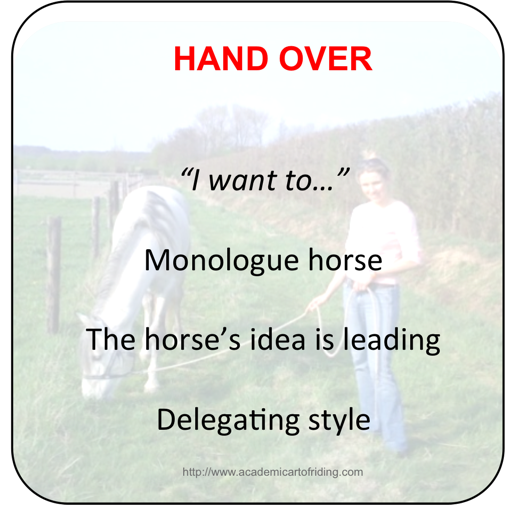
In this style, the leader allows the horse to make decisions. However, you as the leader maintain the final responsibility.
The ‘hand over’ style is more like a monologue with the horse expressing his ideas and his wants.
This style can improve or destroy the relationship between horse and rider:
- This style often occurs unconsciously when the owner of the horse isn’t a clear leader and therefore the horse is taking the lead. In the absence of a clear leader, a horse will seek to fill what he see as the vacant leadership role. This can lead to stress and behavior problems and can cause dangerous situations because the horse no longer pays attention to the rider while his ideas are leading.
- However, this style can be deliberately used if a rider uses too often the ‘telling’ style. Authoritarian riders spend most times with their horse because they want todo something with him and make him do things all the time. Sometimes that makes a horse suppressed, reserved, timid, shy, tense or completely shut down. The ‘hand over’ style improves the relationship between the rider and his horse, because the rider learns to spend some undemanding time with his horse, he learns to not want to do something and to just be with the horse and follow his ideas. By using this style, the horse can change his negative perception of the rider and can open up.
- This style can also be deliberately used if you feel that the horse is getting tensed during learning a new exersise. Just follow or ‘shadow’ your horse’s breathing, his rhythm and his speed until you feel he relaxes and then continue with the learning process.
Points to note
The extreme version of this style is to not lead your horse at all in any way. But in our domestic world that is almost impossible, because we have a lot of ideas and make a lot of decisions for our horse:
- what, when and how we feed him,
- what barn, stall, shelter he is going to live in,
- where and when we groom him, clean his hooves and where, when and how we shoe him etc.
- when he has to go from A to B, from the stable to the back yard, from the pasture to the forest, to a clinic, to the vet, etc.
If you really prefer to not lead your horse at all, allow your horse to live on a prairie, in a herd, keep sufficient distance and enjoy watching your horse.
Effective leadership
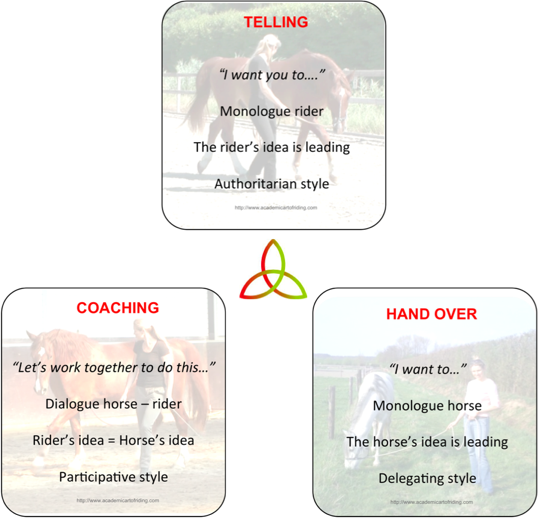
There is no single ‘best’ style of leadership. Different humans, horses and situations call for different leadership styles:
- The most successful leaders are those that adapt their leadership style to the individual horse.
- And effective leadership varies, not only with the horse that is being influenced, but it also depends on the exercise, task or job that needs to be accomplished.
- Good leaders are also constantly observing and training themselves to be the best leader they can be.
A good leader uses all three styles, depending on the leader, the horse and the situation:
- When you teach a horse something new, you use the ‘telling’ style, but if you feel he needs a break to digest what he has just learned, then pause and use the ‘coaching’ style: you use two-way communication and allow him to express his feelings (chewing and licking his lips, lowering or shaking his head, blinking his eyes), and you wait until he is ready to ‘check in’ again (by looking at you with his ears forward). If he checks in, you continue with the ‘telling’ style and give him new direction. When you detect that the horse has a tendency to build tension, you can switch to the ‘hand over’ style by following his breathing and rhythm, so the perceived pressure drops.
- When you use the ‘hand over’ style during in-hand grazing, and the horse starts pulling you disrespectfully, then you can switch to the ‘telling’ style and teach him the rules, limitations and boundaries.
- If your horse uses the ‘hand over’ style all the time, by not paying attention to you, by stepping on your feet, by acting alert, nervous or aggressive, you have to switch to the ‘telling’ style. Your clear leadership in the ‘telling’ style will teach him the rules, limitations and boundaries and provide the horse security and safety. When the horse feels safe and comfortable, respects and trusts you, you can switch to the ‘coaching’ style.
- When you use the ‘coaching style’ at liberty, but your horse gets confused or doesn’t understand you or drops out during the dialogue, you can switch to the ‘telling’ style and explain what you mean. At the end of the session you can switch to the ‘hand over’ style and for example let him roll on the ground after work.
- When you use the ‘telling style’ a bit too authoritarian, and you experience that the horse withdraws mentally, you can switch to the ‘hand over’ style to see what happens. If your horse’s reaction is “Bye, I’m outta here”, you need to change your approach and use more of the ‘coaching’ style. If your horse is hard to catch, you can use the ‘hand over’ style to improve your relationship with your horse.
- You can teach the horse new exercise by using tools like a cavesson, bridle, rein or longe line in the ‘telling’ style. You can check his willingness and self motivation by taking away the tools and use the ‘coaching style‘ at liberty.
The entire time you work with your horse you have to be checking yourself, the horse and the situation and adapt your leadership style.

